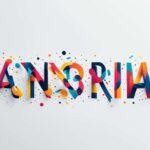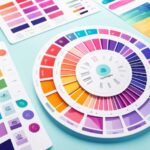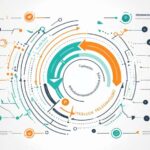Table of Contents
Welcome to our article on the latest trends in UI design for 2024. As we enter the new year, the world of UI design is undergoing a transformative shift. Balancing aesthetics with functionality and adapting to user behaviors are key challenges for designers. In this article, we’ll delve into the cutting-edge trends that are shaping the UI design landscape in 2024, from generative design to bold typography, complex gradients, glassmorphism, augmented reality, parallax effect, brutalism, hyperrealism, and more.
Stay with us as we explore the fascinating world of UI design and discover how these trends can elevate the digital experience for users in 2024.
Generative Design
Generative design is an emerging trend in UI/UX that leverages artificial intelligence and algorithms to create dynamic and adaptable user interfaces and experiences. By utilizing the power of AI, generative design can automatically generate layouts, color schemes, typography choices, and even content based on user interactions, data inputs, or predefined parameters. This revolutionary trend is transforming the design process, enabling designers to deliver more personalized and responsive user experiences.
With generative design, UI/UX professionals can harness the capabilities of AI to create interfaces that continuously evolve and adapt to users’ needs and preferences. By analyzing user inputs and behavior, generative design algorithms can generate UI elements in real-time, optimizing the overall user experience. This approach enables designers to break away from static and rigid design patterns, ushering in a new era of flexibility and innovation.
Through generative design, UI/UX practitioners can benefit from the vast potential of AI-driven creativity. By incorporating generative design techniques into their workflows, designers can significantly streamline their processes, while also exploring new design possibilities. The fusion of human creativity and artificial intelligence produces unique and captivating user interfaces that elevate the overall user experience.
Implementing generative design also allows for greater efficiency and productivity. Automation of certain design tasks, such as layout generation or color selection, enables designers to focus on more complex and strategic aspects of their work, leading to improved productivity and faster turnaround times.
Incorporating generative design into UI/UX practices enables designers to provide users with highly personalized and responsive experiences. By relying on artificial intelligence, interfaces can adapt to individuals’ preferences and behaviors, enhancing user satisfaction and engagement.
Generative design is also a powerful tool for designers seeking to push the boundaries of creativity and innovation. By leveraging AI capabilities and algorithms, designers can explore uncharted design territories and create user interfaces that surprise and delight users. This approach allows for the exploration of unconventional design solutions that can spur groundbreaking innovations.
Benefits of Generative Design:
- Personalized and adaptive user experiences
- Streamlined design processes
- Enhanced user satisfaction and engagement
- Expanding creative possibilities
- Accelerated productivity and efficiency
Generative design is not only shaping the future of UI/UX, but it is also revolutionizing the way designers approach their work. By harnessing the power of artificial intelligence, generative design enables designers to create interfaces that are truly tailored to the needs and preferences of users. This trend represents a significant step forward in user-centric design and has the potential to unlock new levels of creativity, personalization, and innovation.
Bold Typography
In 2024, bold typography continues to be a popular trend in UI design. The use of larger-than-life, assertive fonts instantly captures user attention, making a strong impact and setting the tone for the overall design. By strategically incorporating bold typography into interfaces, designers can create a visual hierarchy that guides users through content effortlessly, ensuring key messages are conveyed effectively.
With bold typography, designers have the power to emphasize important information and create a seamless reading experience. By carefully selecting font styles, sizes, and weights, they can influence how users perceive and interact with the design. Whether it’s a headline, call-to-action button, or key piece of information, bold typography draws the eye and encourages user engagement.
In addition to its attention-grabbing nature, bold typography can be combined with other design elements to enhance the overall impact and engagement of the UI. Mixing bold typography with 3D elements, illustrations, or vibrant colors adds depth and dimension to the design, creating a visually captivating experience.
When executed successfully, bold typography not only improves the aesthetic appeal of the UI but also helps establish a clear visual hierarchy, allowing users to navigate through the content with ease. By emphasizing important elements and guiding user attention, bold typography plays a crucial role in creating an intuitive and user-friendly interface.
Complex Gradients
Gradients have taken the UI/UX design scene by storm in 2024. The use of complex and animated gradients adds depth, richness, and a sense of sophistication to digital interfaces. By leveraging the psychology of color, designers can evoke specific emotions and convey brand messages. This trend offers an opportunity to create immersive and visually striking user experiences, moving away from static color schemes and introducing dynamic elements.
“Complex gradients are a game-changer in UI/UX design. They allow designers to create visually captivating experiences that engage users on an emotional level. By combining multiple colors and shades in a seamless transition, complex gradients add depth and dimensionality to digital interfaces. Whether it’s a subtle gradient overlay or a bold gradient background, this trend adds a touch of sophistication to any design.”
With complex gradients, designers have the flexibility to experiment with a wide range of color combinations and gradients. From vibrant and energetic gradients to subtle and calming ones, the possibilities are endless. By carefully selecting and blending colors, designers can create visual engagement that captures the attention of users and keeps them immersed.
Furthermore, complex gradients can evoke a variety of emotions, enhancing the user experience. For example, warm and vibrant gradients can convey energy and excitement, making them ideal for interfaces related to entertainment or fashion. On the other hand, cool and soothing gradients can create a sense of calmness and tranquility, which may be suitable for meditation or wellness apps.
Benefits of Complex Gradients in UI/UX Design
Emotional Appeal: The use of complex gradients enables designers to tap into the psychological impact of color, evoking specific emotions and creating a memorable user experience.
Visual Engagement: The dynamic nature of complex gradients adds visual interest, capturing the attention of users and keeping them engaged with the interface.
Depth and Dimension: The layering of multiple colors and shades in complex gradients adds depth and dimensionality to otherwise flat designs, creating a more immersive experience.
Brand Differentiation: By incorporating complex gradients into their UI designs, brands can stand out from the competition and create a unique visual identity.
| Benefits | Description |
|---|---|
| Emotional Appeal | The use of complex gradients enables designers to tap into the psychological impact of color, evoking specific emotions and creating a memorable user experience. |
| Visual Engagement | The dynamic nature of complex gradients adds visual interest, capturing the attention of users and keeping them engaged with the interface. |
| Depth and Dimension | The layering of multiple colors and shades in complex gradients adds depth and dimensionality to otherwise flat designs, creating a more immersive experience. |
| Brand Differentiation | By incorporating complex gradients into their UI designs, brands can stand out from the competition and create a unique visual identity. |
With complex gradients, designers can create visually captivating interfaces that leave a lasting impression on users. Whether used as a background, in buttons, or as subtle accents, complex gradients have the power to transform the overall look and feel of a digital product, enhancing user engagement and satisfaction.
Glassmorphism
Glassmorphism is an intriguing design trend that takes inspiration from frosted glass elements, seamlessly integrating depth, transparency, and a frosted glass aesthetic into digital interfaces. By incorporating glassmorphism, UI/UX designers can create visually captivating and modern user experiences.
This design trend leverages the concept of transparency, allowing UI elements such as cards, modals, and navigation panes to resemble frosted glass. The use of glassmorphism adds a subtle blur and a sense of depth, creating an elegant and sleek visual style.
With glassmorphism, the visual hierarchy of the interface is enhanced as the translucent elements stand out against the background, capturing users’ attention and guiding them through the content effortlessly. This effect also creates a sense of interaction and realism, as if the user is interacting with physical objects.
Glassmorphism provides a versatile design approach, suitable for various applications, from mobile apps to web interfaces. It complements different design styles, ranging from minimalist to bold and vibrant, making it a popular choice among designers.
This design trend aligns with the principles of UI/UX design, as it focuses on delivering visually appealing and user-centric experiences. The transparency and frosted glass aesthetics of glassmorphism create an intriguing balance between visibility and subtlety, enhancing the overall usability and engagement of digital interfaces.
Advantages of Using Glassmorphism
When implemented thoughtfully, glassmorphism offers several advantages:
- Enhanced visual appeal: Glassmorphism adds a touch of elegance and sophistication to digital interfaces, making them visually captivating and memorable.
- Improved user experience: The subtle blur and transparency effects of glassmorphism create a sense of interaction and realism, enhancing the overall user experience.
- Flexible integration: Glassmorphism can be seamlessly integrated into different design styles and applications, allowing for versatility and adaptability.
- Guided user attention: The translucent elements of glassmorphism stand out against the background, guiding users through the content effortlessly and improving the visual hierarchy of the interface.
Overall, glassmorphism is a design trend that continues to evolve and adapt, offering UI/UX designers a modern and sleek visual style to create immersive and engaging user experiences.
Augmented Reality (AR)
Augmented reality (AR) has been a popular trend for several years, and its popularity is expected to continue in 2024. With advancements in AR technology, UIs with augmented reality support are becoming more prevalent. AR enables the merging of the physical and digital worlds, providing users with enhanced possibilities and experiences. It is particularly valuable in educational apps or projects that involve working in hazardous environments. The demand for AR-based UIs is expected to rise due to its profitability and support from major companies like Apple.
Parallax Effect
The parallax effect is a popular technique in UI design that creates depth and immersion. By moving background, middle-ground, and foreground elements at different speeds, a compelling illusion of three-dimensional space is achieved. This effect adds visual interest and enhances user engagement, especially when applied to websites or apps with scrolling functionality. To ensure a smooth user experience, it is crucial to optimize the responsiveness of the parallax effect across various devices and screen sizes.
| Benefits of Parallax Effect in UI Design | Challenges in Implementing Parallax Effect |
|---|---|
|
|
Conclusion
In conclusion, the UI design trends for 2024 offer exciting opportunities for designers and businesses to enhance the digital experience. These cutting-edge technologies and trends redefine the boundaries of UI/UX design and provide a fresh perspective on user interfaces and experiences.
Generative design, the use of artificial intelligence and algorithms to create dynamic user interfaces, allows for more personalized and responsive experiences. Bold typography with its larger-than-life fonts captures user attention, while complex gradients add depth and emotional appeal to digital interfaces.
Glassmorphism, the trend inspired by frosted glass aesthetics, offers a sleek and modern look, and augmented reality opens up new possibilities for merging the physical and digital worlds. The parallax effect creates depth and immersion in UI design, providing users with unique scrolling experiences.
By incorporating these trends into their workflows and strategies, designers can create visually captivating and user-centric interfaces that drive the success of their products. Embracing these UI design trends will ensure that businesses stay ahead in 2024 and create memorable experiences for users.
FAQ
What is generative design in UI/UX?
Generative design is an emerging trend in UI/UX that utilizes artificial intelligence and algorithms to create dynamic and adaptable user interfaces and experiences. It involves automatically generating layouts, color schemes, typography choices, and even content based on user interactions, data inputs, or predefined parameters.
How does bold typography impact UI design?
Bold typography is a trend that will remain popular in 2024. The use of larger-than-life, assertive fonts helps make a statement and instantly capture user attention. By strategically incorporating bold typography into interfaces, designers can create a visual hierarchy that guides users through content effortlessly. Additionally, mixing bold typography with other styles, such as 3D or illustrations, can enhance the overall impact and engagement of the design.
What are complex gradients in UI/UX design?
Gradients have taken the UI/UX design scene by storm in 2024. The use of complex and animated gradients adds depth, richness, and a sense of sophistication to digital interfaces. By leveraging the psychology of color, designers can evoke specific emotions and convey brand messages. This trend offers an opportunity to create immersive and visually striking user experiences, moving away from static color schemes and introducing dynamic elements.
What is glassmorphism in UI/UX design?
Glassmorphism is a design trend that draws inspiration from frosted glass elements, incorporating depth, transparency, and a frosted glass aesthetic into digital interfaces. This effect can be applied to various UI elements, such as cards, modals, or navigation panes. While glassmorphism has been around for some time, it continues to evolve and adapt according to current tastes and preferences, offering a modern and sleek visual style.
How does augmented reality impact UI Design?
Augmented reality (AR) has been a popular trend for several years, and its popularity is expected to continue in 2024. With advancements in AR technology, UIs with augmented reality support are becoming more prevalent. AR enables the merging of the physical and digital worlds, providing users with enhanced possibilities and experiences. It is particularly valuable in educational apps or projects that involve working in hazardous environments. The demand for AR-based UIs is expected to rise due to its profitability and support from major companies like Apple.
What is the parallax effect in UI/UX design?
The parallax effect is a visual technique often used in UI/UX design to create depth and a sense of immersion. By moving background, middle-ground, and foreground elements at varying speeds, the illusion of three-dimensional space is achieved. The parallax effect adds visual interest and engagement to websites or apps, providing a unique scrolling experience. It is important to ensure the responsiveness of this design trend across different devices and screen sizes for a smooth user experience.













